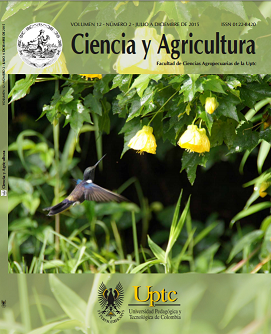Soil ecological restoration applying biochar (charcoal) and its effects on the Medicago sativa production

Abstract
ln the province of Chimborazo, Riobamba canton, and San Pedro of Abras neighborhood (Ecuador) an ecological restoration on the soil was studied by applying different levels of charcoal (10, 20 and 30 tha") and its effect on the alfalfa Medicago sativa forage production was evaluated, under a block design completely randomized. The best results were obtained by applying 30 t.ha'“ charcoal, in this way: In the first cut was reached the lowest flowering time occurrence (40,50 days) the highest basal coverage (39,35%) and highest aerial coverage (86,0%) the best height (87,98 cm) and the highest numbers of leaves per stem (103,45) and above all the highest forage production, both in green material (15,80 t.FV"ha" cut) as in dried one (33,38 t.MS'“ha'l year). In the second cut was achieved the best basal cover (86,55%) and aerial (95,42%) as well the largest production in green forage (15,92 t.ha'lcut), and in dry matter (33,70t.MS'lha'l year). The economical analysis registered the highest profitability with the 30 t.ha'“ of charcoal cost-benefit of$ 1,63.
lt’s recommended to apply in Medicago sativa 30 t.ha" of charcoal, because with it a larger amount of green forage by cut was obtained and improved the soil quality, which will guarantee to obtain economic returns that benefit the agricultural and livestock producers.
Keywords
alfalfa, charcoal, soil ecological restoration.
References
- Vargas O. 2011. Guía metodológica para la restauración ecológica del bosque altoandino. Grupo de Restauración Ecológica. Departamento de Biología. Universidad Nacional de Colombia. Recuperado de http://es.scribd.com/doc/58772431/Guia-Restauracion-Ecologica.
- Fernández I., Morales N., Olivares L., Salvatierra J., Gómez M., Montenegro M. 2010. Restauración ecológica para ecosistemas nativos afectados por incendios forestales. Fundación ECOMABI. Chile. Recuperado de http://www.conaf.cl/wp-content/files_mf/1363716217res_baja.pdf.
- Jackson L. 2002. The role of ecological restoration in conservation biology. Estados Unidos: Ediciones Fielder and Jain.
- Lehmann J. and Joseph S. 2009. Biochar for Environmental Management: An Introduction en Biochar for Environmental Management - Science and Technology. Cornell University, USA. Recuperado de http://www.css.cornell.edu/faculty/lehmann/publ/Lehmann%20and%20Joseph%202009%20Introduction%20to%20Biochar.pdf.
- Centro Internacional de Agricultura Tropical, CIAT. 2011. Evaluación de pasturas con animales. Colombia: autor. Ediciones CIAT.
- Pérez E. y Carril U. 2009. Fotosíntesis: Aspectos Básicos. Reduca Biología. Serie Fisiología Vegetal. 2(3):1-47. Recuperado de http://eprints.ucm.es/9233/1/Fisiologia_Vegetal_Aspectos_basicos.pdf.
- Pérez A., Céspedes C., Núñez P. 2008. Caracterización física-química y biológica de enmiendas orgánicas aplicadas en la producción de cultivos en República Dominicana. Revista Ciencia Suelo Nutrición Vegetal, 8(3) Temuco. Recuperado de: http://www.scielo.cl/scielo.php?script=sci_arttext&pid=S0718-27912008000300002.
- Robert M. 2002. Captura de carbono en los suelos para un mejor manejo de la tierra. Informes sobre recursos mundiales de suelos. Francia: Institut National de Recherche Agronomique. Organización de las Naciones Unidas para la Agricultura y la Alimentación. Recuperado de ftp://ftp.fao.org/agl/agll/docs/wsrr96s.pdf.
- Imbach A. 2009. Formulación de un proyecto de conservación de los recursos naturales para la zona de pendientes del proyecto Chinorte, Nicaragua. Informe de consultoría. San José, Costa Rica: Ediciones UICN.
- Pnuma W. 2001. Cuidar la tierra: Estrategia para el futuro de la vida. Suiza: Ediciones Alpes.
- Martínez H., Fuentes P., Acevedo E. 2008. Carbono orgánico y propiedades del suelo. Revista Ciencia Suelo Nutrición Vegetal, 8(1). Santiago de Chile. Recuperado dehttp://www.scielo.cl/scielo.php?script=sci_arttext&pid=S0718-27912008000100006.
- Alarcón Z. 2007. Producción de forraje verde para ganado bovino en invierno. Reporte de resultados primer año. Instituto de Investigación y Capacitación Agropecuaria, Acuícola y Forestal del Estado de México. México: Ediciones Universidad Autónoma de Chapingo.